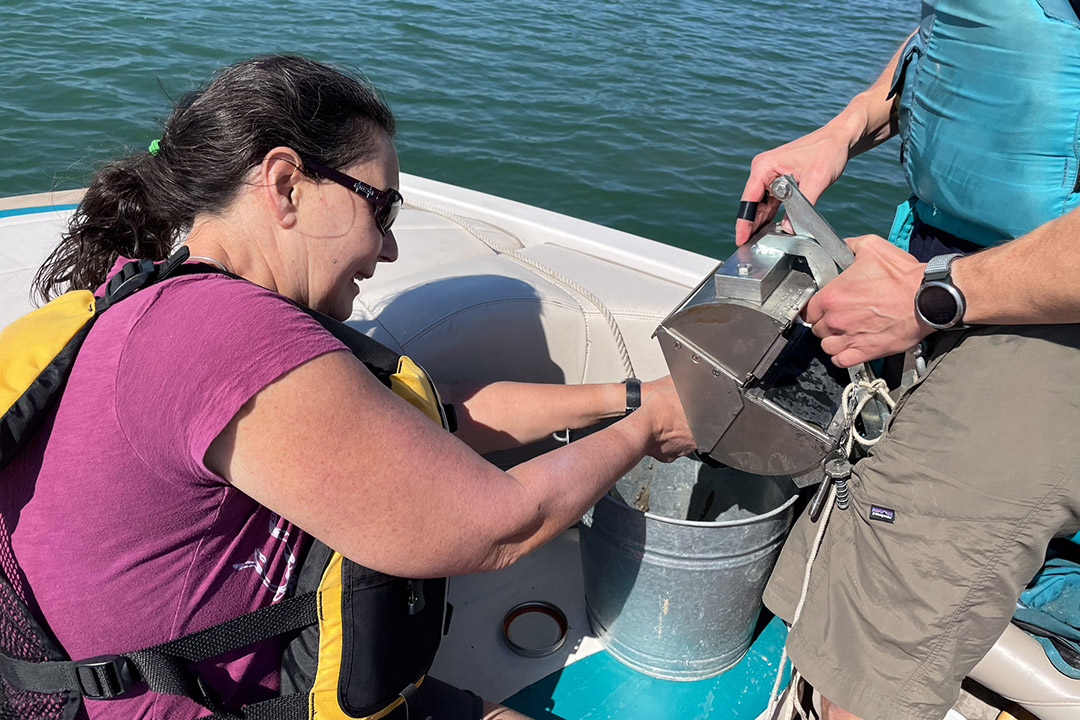RIT and NY Sea Grant to expand marine debris and plastic pollution research and education
New federal funding will bring research project into more urban communities in the Great Lakes watershed
Steven Day
Christy Tyler samples sediment in Lake Ontario as part of her extensive research in marine debris.
A team of researchers at RIT is expanding its work in studying the impact of marine debris beyond the Rochester region and into nearby Great Lakes communities.
As part of recently announced National Oceanic and Atmospheric Administration (NOAA) and Department of Commerce funding, Christy Tyler, professor in the Thomas H. Gosnell School of Life Sciences, and Mary Austerman, a coastal community development specialist with the New York Sea Grant, will lead a project to bring educational programs centered on stormwater debris to the cities of Buffalo and Syracuse.
“Over the past year, our community coalition developed a successful debris interception and education program in Rochester, the Community Action for Stormwater Clean-Up and Debris Elimination (CASCADE) program,” said Tyler. “We are thrilled to be able to continue our work in Rochester and expand CASCADE through new meaningful partnerships in Buffalo and Syracuse.”
The project will bring LittaTraps into more storm drains across the upstate New York region, with a focus on locations where youth can be involved in collection of debris and development of prevention and reduction solutions. LittaTraps are designed to capture debris that enters storm drains, with many already placed in areas around Rochester.
The goal of this expanded work is to create a larger interconnected network that actively prevents and remedies debris pollution in Western New York and the Lake Ontario and Lake Erie watersheds.
“This project expands the successful partnership-driven installation of trash capture technology and educational outreach in Rochester to other Great Lakes cities. We are excited to expand the network of New York state’s urban communities, agencies, NGOs, and teachers focused on keeping plastics and other debris out of the broader environment,” said New York Sea Grant Associate Director Katherine Bunting-Howarth.
Once the trash is collected from the LittaTraps, samples are analyzed to determine how much plastic collects, the sources of the plastic debris, and how that debris moves through the watershed. The data analysis will be used to develop marine debris prevention strategies.
Partners in the new project include the University at Buffalo and Syracuse University. The Seneca Park Zoo Society, Rochester Museum and Science Center, Monroe County, the City of Rochester’s Department of Recreation and Youth Services, and SRGMF consulting are Rochester-based partners in the project.
The project team includes Nathan Eddingsaas, professor in the School of Chemistry and Materials Science; Matthew Hoffman, professor in the School of Mathematics and Statistics; Kaeti Stoss, an environmental education specialist with RIT; and Jacob Anderson, water quality specialist with New York Sea Grant.
Funding for this project is part of the federal administration’s $27 million investment made available under the Bipartisan Infrastructure Law to support community-driven marine debris solutions, including prevention and removal. The project, which is receiving $300,000, is one of 10 Marine Debris Community Action Coalitions selected for funding, which engages communities, groups, and localities, particularly those that have been historically underserved. The selected projects support innovative research and foster local coalitions to address urgent marine debris issues by using the NOAA Sea Grant’s partnered approach to bring science together with communities for solutions that work.
Tyler is involved in extensive work studying marine debris and microplastics in the region. She is the co-director of The Lake Ontario Center for Microplastics and Human Health in a Changing Environment, a collaborative research center with the University of Rochester that was launched earlier this year. She and Hoffman have also received previous funding from the NOAA and New York Sea Grant to investigate plastic waste entering the Great Lakes and the development of prevention and removal measures.
As a coastal community development specialist with New York Sea Grant, Mary Austerman works with community leaders and citizen groups throughout New York’s Great Lakes region address barriers and opportunities related to building their resilience to extreme weather events, storm surge, storm water management, and watershed water quality. She is accompanied in this work by New York Sea Grant’s Great Lakes Literacy Specialist Nate Drag and Water Quality Specialist Jacob Anderson. New York Sea Grant is a partner on NOAA Marine Debris Plans for the Great Lakes, Mid-Atlantic and Long Island, and a partner in four projects receiving a total of $5.9 million in the recent federal grants funding. Austerman is based at New York Sea Grant’s Newark, New York, office in Wayne County. New York Sea Grant is a cooperative program of Cornell University and the State University of New York.
